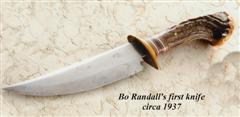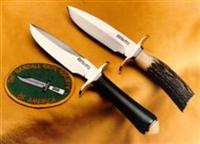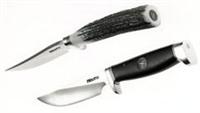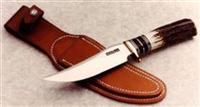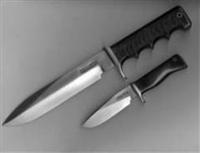Hi Ben,
Are you referring to the '45 catalog on page 107 and the '48 catalog on page 114 or ? If so (1) The '45 catalog states that the Model one is "over 3/16" thick" and the Model 3 is "approximately 3/16" thick" (2) The '48 catalog states the Model 3 is "1/8th to 3/16" thick".
I haven't seen as many early fighters as Joe or Tune, but I've seen quite a few and they were all made from 1/4" stock with a finished thickness of "over 3/16" (Which jives with the '45 catalog discription).
The early Hunters / Model 3's are a different story: I have one pre-war Hunter and it was made from 1/4" stock. That's only one data point, so I can't vouch for any others. I've owned 9-10 WWII Hunters and with the exception of just one, all were made from 3/16" stock. All post WWII Model 3's I've
ever seen or owned have been made from 1/4" stock with the one exception of a C 1960 "display model" with an 8 1/2" blade that was made from 3/8" stock. I think you can say as a general rule that WWII Hunters were made from 3/16" stock and post WWII Model 3's were made from 1/4" stock. The '45 catalog discription is correct: A finished post war Model 3 made from 1/4" stock would be "approximately 3/16" thick. The '48 ( and '52 and '53) catalog discriptions are just flat wrong. They are describing the actual thickness of a WWII Hunter. Why the error was made and why it was not corrected over a 5 year period is beyond me.
The only knives I've seen that were made from 1/8" stock were two of the first nine Model 8's made in the 4th quarter of 1946. IMO they were just too thin to be useful for anything but very delicate work and apparantly Bo felt the same way as I've never seen any others made after those first nine that were not made from 3/16" stock.
Best,
Ron
_________________________
Ron Mathews
RKS No. 4223

